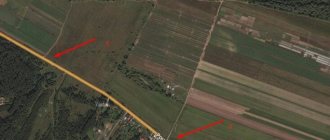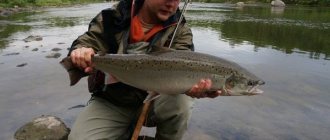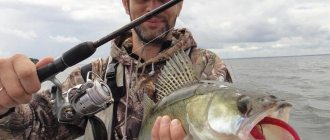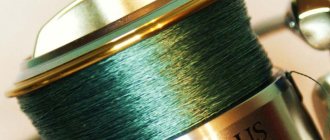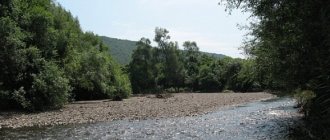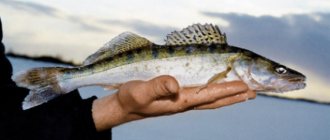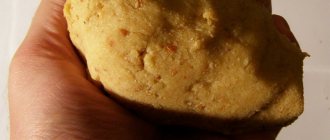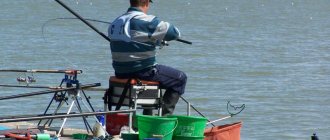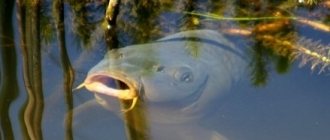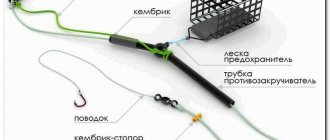Fishing in the Gulf of Finland: features and cool places
To many, the Gulf of Finland resembles a freshwater lake. The natural feature is due to the huge influx of river water and shallow depths. The water salinity is minimal – 0.2–9.4%. Nature itself has carefully created places that have long been favored by fish. The reservoir has long attracted hundreds of fishing enthusiasts. The area of the bay's water surface is 29,500 square meters. km.
The length of the reservoir is 420 km, the width varies from 70 to 130 km. The maximum depth is 121 m, the average value reaches approximately 38 m. The winter water temperature balances around zero, in the summer the water warms up to 17 degrees Celsius at the surface. At the bottom it continues to remain 2–3 degrees.
The reservoir freezes from the end of November to April, but in rare years when the winter months are not characterized by low temperatures, it remains free of ice cover all year round. The shallowest part of the bay is the eastern part. It is separated by a dam. It must be remembered that some areas of the bottom were artificially deepened.
The sandy shores of the northern part of the reservoir have become the location of tourist centers, recreation centers, and comfortable boarding houses. It is these places that have become favorite fishing piers, where the best fishing spots in the Gulf of Finland are located. The northwestern part is distinguished by great depths and steep steep banks.
Ideal place
There is a special place in the bay - “Marquis's Lawn”. It attracts many fishermen, young and old. This is a great place to spend a weekend or even stop by for a few hours after work. This is an ideal place for fishing. You can catch fish in the first few hours you spend near the pond.
In winter, when the bay is frozen, roach bite well. The timing of fishing is important. Roaches will be better off taking bait at night. Knowing the behavioral characteristics of fish will play into your hands. In fishing, all the nuances are important, such as the habits of the fish and the preferred bait. It is better to catch schooling fish in a large school. In this case, for a good bite you just need to feed it.
The Gulf of Finland extends beyond Russia. Part of it is located in Finland. Fishermen planning to fish on the other side must have a foreign passport. But it has been verified that the bite here is no worse than abroad. Everyone will remember a holiday in the Leningrad region on the Gulf of Finland.
The best fishing spots in the Gulf of Finland
| Damba - summer fishing with a feeder and float | |
| The dam is the only place for fishing on the Gulf of Finland from the shore where you can actually catch white fish (roach, silver bream, bream). They use donkeys, ordinary float rods, and a feeder for fishing. Various attachments are suitable: live worms, bloodworms, maggots. Much less often, fish take bread, steamed cereal grains, or semolina mash | |
| Damba - winter smelt fishing | |
| What is winter without smelt! They follow it to the Gulf of Finland, starting from the establishment of the first ice. Fish like the local depths and currents. Until early spring, they enjoy their catches of local, somewhat small “cucumber” fish. But with the first days of spring, large schools of Baltic smelt come to the waters of this part of the bay. It is larger, the meat has different flavor notes. | |
| Duderhof Canal - fishing in winter and summer | |
| Dudergovsky Canal - convenient descents, excellent stocking of fish, good transport links attract fishermen from all over St. Petersburg. Here you can catch crucian carp, roach, perch, pike and even large carp. | |
| Strelna - fishing in the yacht club | |
| Strelna - fishing in the yacht club Strelna is not only the location of the famous St. Petersburg yacht club, but also a meeting place for avid fishermen. Fishing is carried out all year round. Here they catch bream, roach, perch and pike perch - in all possible ways. | |
| Lakhtinsky Razliv - fishing | |
| The large fish that live in the Lakhtinsky Razliv are resourceful. Large specimens of perch and pike are caught in the best traditions using spoons, vibrotails, and spinners. While honing your skills, you sometimes catch a hefty pike perch. | |
| Depth maps of the Gulf of Finland 2015 | |
| The Gulf of Finland is a wonderful fishing place. By studying the updated depth map, you will get maximum information. She will help you choose a “cool” place, choose the right gear, and get the right bait. Relax in style, get close to nature, and enjoy the rich catches. | |
Features of fishing and biting places
For many, the bay will look like a large lake. Natural conditions made it shallow with a large supply of fresh water. The water here is slightly salted - from 0.2 to 9.4%. The resulting water spaces were loved by many species of fish. They are also popular with fishermen, of whom there are always many on this body of water. The water surface covers almost 30 thousand square kilometers. The dam on the Gulf of Finland is a special place.
The dimensions of the bay are as follows: length 420 kilometers and width 70-130 kilometers. At the deepest point the bottom is 121 meters, and the average depth is about 38 meters. In winter, the water temperature is around zero, and in summer it rises to 17ºC. In the area of the bay bottom it is constant and amounts to 2-3ºC.
The reservoir becomes covered with ice in late November, and is freed from it only in April. There are winters without severe frosts, and then ice does not form on the surface of the bay. The east of the bay is the shallowest and is fenced off by a dam. It is worth knowing that there are places at the bottom that were buried by man.
The sandy beaches of the north of the bay have become a haven for many tourist centers and boarding houses with all amenities. At the same time, fishermen also fell in love with them, because here are the best fishing spots in the entire reservoir. In the north-west of the reservoir there are the greatest depths and steep banks. It is best to go fishing in June.
Spring fishing on the Gulf of Finland
Fishing in spring is divided into 2 periods: from ice; from clean water. The ice becomes decrepit, but skilled fishermen use methods and gear of “winter” fishing until the water appears clear of ice blocks, which happens by the end of April. It is in the third decade that schools of perch spawn near the shore, where the lures of competent fishermen await them. They fish with spinning rods.
Repino, beautiful Zelenogorsk, Komarovo are the best places for catching perch and roach, especially in the winter months. In spring, it is excellent to catch saberfish here. Convenient access makes the area especially favorite for those who like fishing in large groups.
The settlement of Sands or 22 km is a place of sharp deepening of the Gulf of Finland. Already a kilometer away from the coastline, the depth reaches 25 meters. The relief of the bottom attracts schools of smelt here, and fishermen cheerfully pull out fishing rods with “cucumber” fish. You can get to the “cool” place from Zelenogorsk by an old diesel train or by bus.
In front of the settlements of Vysotsk and Manola, the bottom is deepened directly off the coast, which makes smelt fishing comfortable and safe. Rarely, schools of blackbacks visit these places, which causes special excitement among fishermen.
Fishing for pike perch in summer
In the northern part of the bay, pike perch fishing picks up from mid-June. It bites on white nights, and not only at the bottom, but also hunts on the surface, and even near mid-water. Take wobblers if you plan to fish by trolling. It is this method that is loved by today’s fishermen, although many continue to use jig baits. For a successful catch, you need to move significantly away from the shore, so it would be useful to have an echo sounder and navigator with you. The echo sounder will tell you the best bottom reliefs that pike perch love.
Along with pike perch, perch is caught - an inhabitant of identical places. In the Northwestern part, pike perch sometimes attack jigs designed to catch smelt. In winter, small pike perch are caught on vertical spoons, sometimes on balancers.
Autumn pike fishing
Autumn pike fishing is a test of the angler's skills. A spinning rod of 2.1–2.4 m with a powerful reel is suitable; the clutch is installed almost tightly. Pay attention to places covered with water lilies, reed thickets, and reeds. Take a closer look and you will definitely see corridors, windows, and free passages. Throw bait generously there.
Take a powerful cord into your rig. It will ensure reliable “dragging” of the toothy predator right through the thickets. Light lures that “jump” out of the water won’t help, but “non-hooking” ones are the best helpers in securing large catches. A minimum weight of 22 g and 8 cm is the minimum length of the prepared bait.
Inspect the areas carefully. Be sure to find pike hunting trails. It may take several days, but there will definitely be a generous reward for your efforts. Don’t be particularly upset the first time you unsuccessfully swallow the bait, because the pike will certainly return after a few bites.
Add a fishing spot on the Gulf of Finland
Summer pike perch fishing
By mid-June, pike perch fishing in the northern part increases. On white nights it hunts both at the bottom and on the surface. When trolling, don't ignore wobblers. Although many people traditionally use jig baits, trolling is becoming the most popular. Since the bite is best far from the shore, it is worth taking with you a navigator and an echo sounder, which allows you to identify areas of the relief bottom that are a frequent habitat for pike perch. Perch is also a trophy fish in similar areas.
Features of catching pike perch in the Gulf of Finland
Like perch on Ladoga at the beginning of winter, pike perch in the middle of summer on the Gulf of Finland attracts a lot of admirers of their fishing, numbering in the thousands of anglers.
This is explained quite simply. After all, it’s not far from the city—in fact, it’s even the city itself in a large number of cases. And if not geographically, then administratively.
Accordingly, the infrastructure, roads, gas stations, parking lots, shops are all at a high level. Agree, the opportunity to go fishing on a weekday after work, and at the same time catch culinaryly valuable fish, is worth a lot.
For example, it usually takes me an hour to get from the door of my apartment to the shore. Well, another half hour to prepare - remove the boat, install the motor, assemble a couple of spinning rods.
If you leave at 18.00 - 18.30, then the fishing itself begins just when needed. After all, very often there is simply nothing to do in the Gulf until eight in the evening - it is necessary for the sun to fall and the pike perch to start feeding.
There are, of course, cases when pike perch “hit” wobblers at noon on an absolutely clear day, especially when there is waves (one to one and a half meters), but generally the activation of pike perch begins when the sun noticeably declines to the horizon and a change in illumination in the lower layers of water.
Taking this into account, many can quite catch themselves, then even sleep a little when they arrive home, and the next morning go to work as if nothing had happened. Then - you don’t need any particularly serious watercraft, the most compact boat is quite enough.
The bay is not Ladoga. Here is a completely different wave - a sea wave, rolling, not hard, flooding the cockpit at the slightest yawn.
Even if it is quite high, it is still safe. Subject, of course, to the correct orientation of the bow of the boat.
And pike perch fishing is not carried out at a distance of 20 kilometers from the shore, as is usually the case on Ladoga during the pike perch season, but within the “shot range” - a kilometer, two, three, well, five. This makes it possible to quickly navigate the weather and make a decision to stop or suspend fishing.
Even on a very modest vessel with a small engine. Or even with oars.
And, finally, the opportunity, even despite experience and technical equipment, to almost always catch pike perch. Fishing in the Gulf is not at all difficult, rarely tied to the relief and current, often simply primitive due to the location of the feeding fish and therefore accessible even to complete “candy wrappers”, if of course they are able to simply comprehend the simplest rules and techniques of fishing, which are explained to them by more experienced fishermen.
It is known for certain that the successful outcome of fishing largely depends on the correct choice of place and selection of the right gear. Each fisherman has his own personal opinion on these two questions, but the general principles still remain the same.
In general, fishing in the Gulf of Finland is no different from other bodies of water, but it has its own characteristics and nuances.
According to the rules of amateur and sport fishing, fishing for pike perch in the Gulf of Finland is prohibited until June 15. This is due to the fact that the spawning of this fish occurs at an ambient water temperature of about 15 degrees Celsius. Most often, pike perch spawns in the first ten days of June and, starting from the 20th of the month, you can safely start catching spawned fish.
Experienced fishermen know very well the places where pike perch are caught in the Gulf of Finland.
And here’s what you need to know: Country complex “Moscow Sea”
Most often, schools of spawning fish approach Repino and then move towards Komarovo, Primorsk and Vyborg. Sometimes the time of movement of the pike perch and its route change slightly, but in general its movement occurs in this direction.
Tackle for catching pike perch in the Gulf of Finland
The practice of catching pike perch on the track shows that spinning rods 2.4 - 2.7 m long with a dough from 10 to 50g are optimal for this purpose.
A necessary condition is the presence of a sensitive tip, which allows you to monitor the game of the bait. It is best if the tip is painted in bright colors, which will allow you to notice a bite or improper play of the wobbler in time in any visibility conditions.
In general, the spinning rod should be stiff enough to ensure a high-quality hooking of fish, because pike perch have a very bony mouth.
There are no strict requirements for the choice of reels when fishing for pike perch by trolling. Any options are possible here, but it is still preferable to use inertia-free ones, which allow you to cast over a long distance. Using casting while trolling can significantly save your time.
Considering that even the large pike perch has a relatively narrow food base, the pike perch rarely exceeds 10 cm in size. Therefore, baits for catching pike perch should not be larger than 10-12 cm.
Any fisherman knows for sure that successful fishing, in principle, depends on the correct selection of gear and the correct choice of place for fishing. Catching pike perch also depends on this.
Every fisherman has a personal approach to these two factors, but the general principles are still the same for everyone. Basically, fishing for pike perch in the Gulf of Finland is not much different from fishing in other bodies of water. However, there are also some peculiarities here. So, according to existing rules, fishing for this fish in the waters of the Gulf of Finland is prohibited until June 15.
Such dates are tied to the spawning of pike perch, which begins to spawn when water t0 reaches 150. As a rule, pike perch spawns in early June. And after June 15, you can begin successful fishing for this predatory fish. All experienced fishermen who practice fishing in the Gulf of Finland know the pike perch spots in this body of water very well.
Basically, flocks of spawned pike perch approach Repino and then move towards Komarovo, Vyborg and Primorsk. It happens that the route and movement of schools of pike perch change to some extent, but basically it moves in this direction.
Successful fishing for pike perch in the Gulf of Finland, as noted above, largely depends on the correct choice of gear. For example, fishing for pike perch on the track is optimally carried out with a spinning rod with a length of 2.5 to 2.7 m, with a test weight of 15-50 g.
A necessary condition for such gear is to be equipped with a sensitive tip that allows you to control the game of the bait. It is most practical to paint the top in bright colors; this allows you to notice, even if visibility is not very good, the wrong bait or a bite.
And here's what you need to know: Tents for winter fishing, reviews, types and models of tents, tips for installing them
Also, the spinning rod must have sufficient rigidity to ensure high-quality hooking. Since pike perch has a very bony mouth.
As for reels, there are no special requirements for catching pike perch using the track method, but it is better to use a spinning reel; it allows you to make high-quality long casts.
Long casts during trolling fishing save a lot of time for the angler. Considering the peculiarities of pike perch in that it has a narrow throat, the prey of even very large individuals is fish no more than 10 cm. Therefore, baits for fishing for pike perch should not exceed the size of 10-12 cm.
Free fishing in the Leningrad region
The Leningrad region is rich in reservoirs - more than 25 thousand rivers, more than 40 thousand picturesque lakes. There are an invisible amount of fish here. Experienced fishermen count more than 75 species of fish, but no one gives out fishing spots. Ask the fisherman: “Where did you catch it?” He will definitely wave his hand in the other direction and, at best, say vaguely “there.” Therefore, especially for fishing lovers, about where big and small fish are caught.
Here are the TOP 10 best places where you can fish for free in the Leningrad region:
1. Izhora River
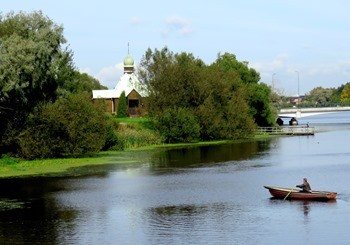
Description, what kind of fish is found, how to get there:
Izhora is a river originating from a spring located in the Gatchina region near the village of Skvoritsy. There is no forest on the shore side, the upper part is distinguished by a large amount of vegetation, the bottom surface is predominantly rocky, and in some places there are sandy areas. The main prey is perch and roach, sometimes medium-sized pike bite, trout and grayling used to be found in the river - today these species are absent due to the deterioration of the environmental situation.
GPS coordinates: 59.61008, 30.2354
Ladoga lake

Description, what kind of fish is found, how to get there:
This is the most popular fishing spot in the Leningrad region. The main prey is roach, perch, pike, pike perch, chub, ruff and eel; If you have a boat, you have a chance to catch ide, grayling and whitefish. You can get to the lake by any type of transport: by car, by bus, by train.
GPS coordinates: 60.86645, 31.51035
Mirror Lake
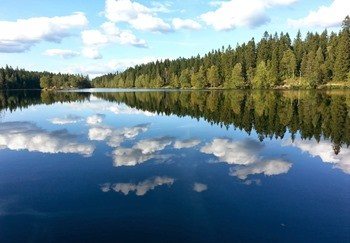
Description, what kind of fish is found, how to get there:
Mirror Lake is a low-flowing reservoir; the shores are slightly hilly with mixed forest. Here, in addition to fishermen, you can often see tourists, but there is plenty of privacy for fishing. The depth in different areas varies from 3.7 to 16 meters, the main prey is bream, roach, perch and ruff; pike is rare; Sometimes pike perch, burbot and tench bite.
To get to the lake you need to turn off the Primorskoye Highway near the village of Zelenaya Roshcha to the Yappilya station.
GPS coordinates: 60.23476, 29.13143
Pioneer Lake

Description, what kind of fish is found, how to get there:
Another fishing place where you can spend time fishing in pleasure. By the way, this is the longest lake in the region and the most transparent and clean. You can see the bottom here. And this is a place not only for those who like to sit with a fishing rod, but also for those who like to swim.
In different parts of the lake you can find ruffe, bream, pike, pike perch, roach, bleak, ruffe and silver bream; There is the opportunity to catch trophy perch.
The lake is located on the Korean Isthmus in the Vyborg region.
GPS coordinates: 60.39297, 28.91476
Alexander Lake
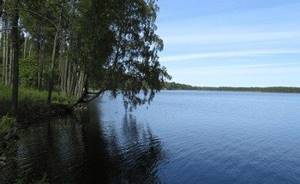
Description, what kind of fish is found, how to get there:
Alexander Lake is located on the eastern side of the previous reservoir; they are connected by a small channel. This lake also has high banks covered with mixed and pine forest; dense vegetation is found only in the north of the reservoir. The most common prey are pike, perch, roach, bream and pike perch; The lake is suitable for fishing from boats, as this is the only opportunity to catch large fish.
GPS coordinates: 60.39606, 28.98207
Vysokinskoye Lake
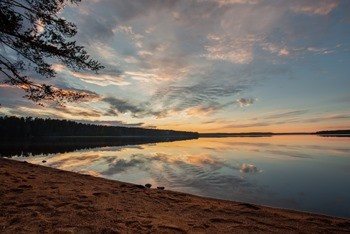
Description, what kind of fish is found, how to get there:
Lake Vysokinskoe is a body of water with an average height of sandy shore, covered with mixed and pine forest. The depth varies from 4 to 12 meters, the bottom is dump, the most promising area is located near the confluence of the Senokosnaya River. The reservoir is popular for fishing for large perch, pike, roach, whitefish, burbot and ruffe; Sometimes you can see pike perch and bream.
GPS coordinates: 60.30613, 28.8791
7. Vukosa River
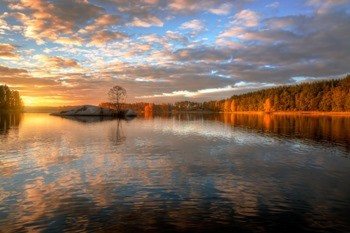
Description, what kind of fish is found, how to get there:
The Vukosa River is located 95 km from St. Petersburg, near the Losevo and Gromovo railway stations. In its waters you can find pike, chub, whitefish, ide and pike-perch, and in the local channels you can catch trout and salmon.
GPS coordinates: 60.75859, 29.77341
Roshchinskoye Lake
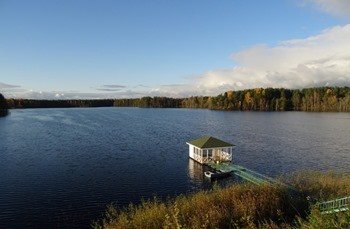
Description of what kind of fish is found:
There are 8 small islands on the lake. The banks are heavily overgrown and fishing is preferable from a boat, but you can cast a fishing rod and spinning rod from the mountainous shore. The lake is rarely visited by fishermen, since it can only be reached by car. The access to the lake is good, close to the water. But you need to look for them. Here you can find: perch, roach, pike, bream, burbot, crucian carp, tench.
How to get there:
Otradnoe railway station. Further - on foot. It is more convenient to get here by car through the village of Torfyanoe at the northern end of Komsomolskoye Lake or through the village of Krasnoarmeyskoye on its western shore.
GPS coordinates: 60.80579, 29.93799
The Gulf of Finland
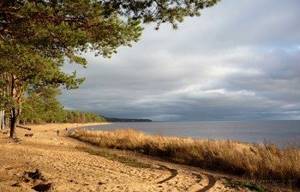
Description of what kind of fish is found:
The Gulf of Finland is famous for its fresh waters thanks to the rivers flowing into it. A number of fish species live here. Most of all, fishermen like the areas of Primorsk, Vyborg, the northern and southern dams. It is best to fish in the bay in cloudy weather. The main places for catching pike perch are Repino, Zelenogorsk, and Resort. Fishing in the Gulf of Finland and adjacent rivers and canals is almost always successful. Bream, pike-perch, roach and perch are caught on donkeys and feeders.
How to get there:
If you decide to try your luck in the dam area, then take a bus, minibus or your own transport to Kronstadt.
GPS coordinates: 60.16499, 29.15731
10. Volkhov River
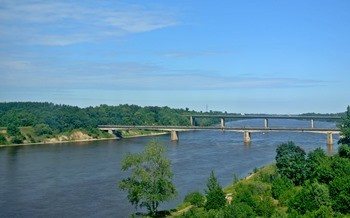
Description of what kind of fish is found:
Excellent fishing awaits you from the boat. From the shore it is also possible, but in certain sections of the river. In the middle of the river there are deep holes where large fish are kept. It is possible to catch considerable pike and pike perch with considerable probability. If luck smiles, you will catch catfish, ide and chub. A great place to sit with a bottom fishing rod on a boat or on the shore is a place near the Volkhov-Most station and in the Novaya Ladoga area.
How to get there:
By train from Moskovsky station in the direction of Malaya Vishera. The drive is more than two hours. Another option is a car.
GPS coordinates: 59.82052, 32.36158
Do you know any other good places for fishing in the Leningrad region - write in the comments

